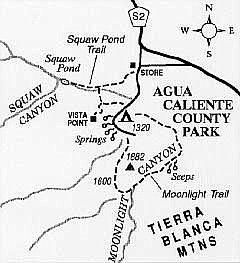 Facebook
Facebook
 X
X
 Instagram
Instagram
 TikTok
TikTok
 Youtube
Youtube
With nothing civilized around it for miles, Agua Caliente County Park/Campground feels like a true oasis amid the vast and desolate dry lands of the Anza-Borrego Desert. Tucked against the skeletal Tierra Blanca Mountains, the site contains several springs and seeps and thickets of vegetation that rely on the year-round presence of surface water. One of the springs yields mineral-rich, warm water that is piped into an outdoor pool. An indoor pool lies nearby, with its water temperature boosted sufficiently to enervate any human body immersed in it for long.
Mini cave, Squaw Canyon
With its small network of trails, Agua Caliente is also a good spot for casual hiking. A short and easy walk, excellent for bird and wildlife watching, leads from the campground to a marshy area politically incorrectly named "Squaw Pond."

Start at the campfire circle near the county park's entrance. Wend your way over a low ridge, passing a spur trail leading to an overlook point a little higher on the ridge, and then descend to a sandy wash -- Squaw Canyon. Turn left and make your way past thickets of mesquite -- now wearing a leafy mantle of narrow green leaves and soon to be festooned with creamy yellow-green flower spikes. Mesquite makes a good living in sandy washes such as these by sending down deep roots that tap into permanent water below. The nutritious pealike pods of the mesquite ripen in September and are eaten by various mammals.
Ahead lies Squaw Pond -- not so much a pond as a soggy, squishy area with several large willow trees and some small palm trees. At least one diamondback rattlesnake makes a living on the small furry creatures who come here to drink. Coyotes and bobcats also frequent this little oasis. On the nearby hillsides you can admire thickets of glistening teddy-bear-cholla cactus and the stout, erect columns of barrel cacti.
Just beyond the "pond," in a jagged ravine to the south (the main Squaw Canyon), is a tiny cave and a usually dry waterfall. Further exploration, by boulder-hopping and sometimes dicey scrambling, is possible up any of the several branches of the canyon.

With nothing civilized around it for miles, Agua Caliente County Park/Campground feels like a true oasis amid the vast and desolate dry lands of the Anza-Borrego Desert. Tucked against the skeletal Tierra Blanca Mountains, the site contains several springs and seeps and thickets of vegetation that rely on the year-round presence of surface water. One of the springs yields mineral-rich, warm water that is piped into an outdoor pool. An indoor pool lies nearby, with its water temperature boosted sufficiently to enervate any human body immersed in it for long.
Mini cave, Squaw Canyon
With its small network of trails, Agua Caliente is also a good spot for casual hiking. A short and easy walk, excellent for bird and wildlife watching, leads from the campground to a marshy area politically incorrectly named "Squaw Pond."

Start at the campfire circle near the county park's entrance. Wend your way over a low ridge, passing a spur trail leading to an overlook point a little higher on the ridge, and then descend to a sandy wash -- Squaw Canyon. Turn left and make your way past thickets of mesquite -- now wearing a leafy mantle of narrow green leaves and soon to be festooned with creamy yellow-green flower spikes. Mesquite makes a good living in sandy washes such as these by sending down deep roots that tap into permanent water below. The nutritious pealike pods of the mesquite ripen in September and are eaten by various mammals.
Ahead lies Squaw Pond -- not so much a pond as a soggy, squishy area with several large willow trees and some small palm trees. At least one diamondback rattlesnake makes a living on the small furry creatures who come here to drink. Coyotes and bobcats also frequent this little oasis. On the nearby hillsides you can admire thickets of glistening teddy-bear-cholla cactus and the stout, erect columns of barrel cacti.
Just beyond the "pond," in a jagged ravine to the south (the main Squaw Canyon), is a tiny cave and a usually dry waterfall. Further exploration, by boulder-hopping and sometimes dicey scrambling, is possible up any of the several branches of the canyon.
Comments